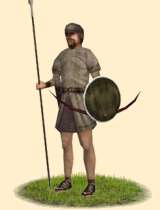Dorkim Shardanim (Sardinian Infantry)
 |
Weapons | Defence | Mental | ||||||
|---|---|---|---|---|---|---|---|---|---|
| Primary | Secondary | Armour: | 1 | Morale: | 9 | ||||
| Type: | none | spear | Shield: | 1 | Discipline: | normal | |||
| Attack: | 3 | 12 | Skill: | 7 | Training: | untrained | |||
| Charge: | 2 | 2 | Recruitment | Other | |||||
| Lethality: | 1 | 0.13 | Soldiers: | 40 | Hit Points: | 1 | |||
| Range: | 157.3 | 0 | Cost: | 775 | Mass: | 0.9 | |||
| Ammo: | 15 | 0 | Upkeep: | 194 | |||||
| Turns: | 1 | ||||||||

The Dorkim Shardanim (Sardinian Infantry) are drawn from the tribes of the Nuragi, a people who lived in Sardinia since an ancient time.
Expert at Hiding in Forests
The Dorkim Shardanim (Sardinian Infantry) are drawn from the tribes of the Nuragi, a people who lived in Sardinia since an ancient time. They fight using a combination of spears and bow, and are prone to tribal skirmishing tactics; as such, their best attribute is to fight with bow at range and withdraw to safety behind stronger melee troops. Being tribal warriors, they are not prone to fighting in long engagements, and are more accustomed to hit-and-run tactics. They are unarmored, have only a buckler, and, as such, unlikely to stand long in a melee even if they were bolder.Historically, the Nuragi, or Nuraghics, were the ancient inhabitants of Sardinia. They constructed Nuraghe, stone towers, for which they are named, and lived in a tribal society. Their families organized into tribes, organized into larger clans, under the control of a patriarch, who was technically a subject of the Carthaginians. They persisted under Carthaginian rule for some decades, until the death of the last patriarch around approximately 210 BC, when the Nuragi, who had been steadily dissolving culturally due to importation of foreign goods and practices, were fully absorbed into the culture of the island's actual rulers.